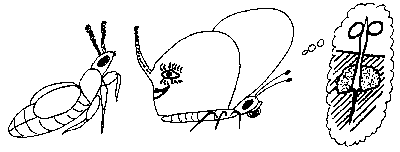
Home
Mission
Overview of Project
Project Staff
Sponsors
Achievements
Checking, Illustrations
Upcoming Activities
Id and Species Lists
Protea Information
Protea Gallery
Growing Proteas
Interim Dist. Maps
Publications
Afrikaanse Inligting
![]()
Phloeonomus looks at Plants with Feet
| Pincushions with feet! I did not believe it. Yet Promerops the Sugarbird was adamant: "Pincushions have feet, believe me or I'll eat you!" he said. So I flew away fast and went to find Myrmechos the ant. I found Myrmechos carrying some fruit: she was squeezing a Silkypuff fruit into her nesthole. She was too busy to stop. "Must work, always work: winter is coming," she said as she popped down the hole. |  |
That was when I met the beautiful "Blue" butterfly called `Lie-sa-in-nid'. Lycaenid (that's how she told me to spell it) told me a tale I could not believe. She introduced herself with "I've seen them - I've seen the Pincushion's feet!"
"You? How? Butterflies do not live underground. And pincushion seeds germinate underground!"
"Calm down, dear Phloeonomys. I'll tell you my story," she said. And I'm afraid there was no stopping her. She talked for hours!
"When I hatched from the egg my mother had layed on a Selago bush, I ate and ate and ate. But the food was not good. It's the fynbos you know! No nutrients - especially no nitrogen. One must have nitrogen to make muscle-building protein! How was I to grow into a big caterpillar without nitrogen? I worried about it a lot. But then I shed my first skin to grow bigger. Hooray, with my second skin I had a large honey gland."
"Oh, you should have seen the ants drink the honey from my gland. They drank and drank. Myrmechos herself `milked' me of my honey. After a few days they carried me down into their nest. There the ants fed me on scraps (and I even ate an ant or two!) So I got plenty of protein. And the ants got plenty of honey."
"One autumn day there were heavy rains. That's when the Pincushion fruit split apart and the root popped out. It started growing downwards. Myrmechos laughed at this and called the seeds stupid: "How are they going to reach the sunshine?" she asked. I just sat and watched - that's when I saw the foot. The foot just stood there, where the root joined the stem. And the stem grew and grew and grew. And the stem pushed the seed right through the roof of Myrmecho's tunnel. The foot is what stopped the root from being pushed down instead of the stem being pushed up! A type of `anchor'. Myrmechos told me that when the stem got to the surface, the fruit coat fell off and the seed leaves popped out to catch the sunshine. And that's my story!"
"But how did you get out of the tunnels?" I asked the little blue butterfly, "one cannot fly in an ant's tunnel!"
"Oh, when I had grown big enough - I had to shed seven skins - I went to sleep and a pupa inside the ants' nest. When I hatched I quickly ran outside the nest. Then I pumped up my wings and flew away! We Lycaenids have done this ever since there was fynbos"
And before I could thank her she had flown away. And do you know - she flew away backwards! I didn't know butterflies could do that. And everyone I asked says that butterflies cannot. Oh, please do write in and tell me if you know how she did it.
Do you want to see the feet of Pincushions? It's very easy. When one of the seeds (oops, fruit) you planted germinates, gently wash it out of the sand with some clean water. Then you will see the foot. Oh yes, I almost forgot! All Proteaceae which are myrmecochorous have a foot. But those, like Proteas, which germinate on the soil surface, well, they don't need feet to push the stem through the soil, do they? Maybe that's why they don't have feet!
'Till next time
Phloeonomus.

Back Phloeonumus Corner